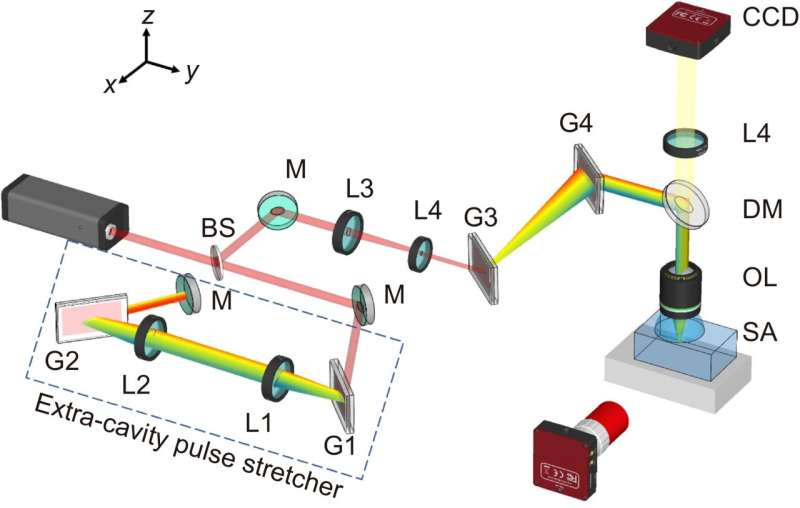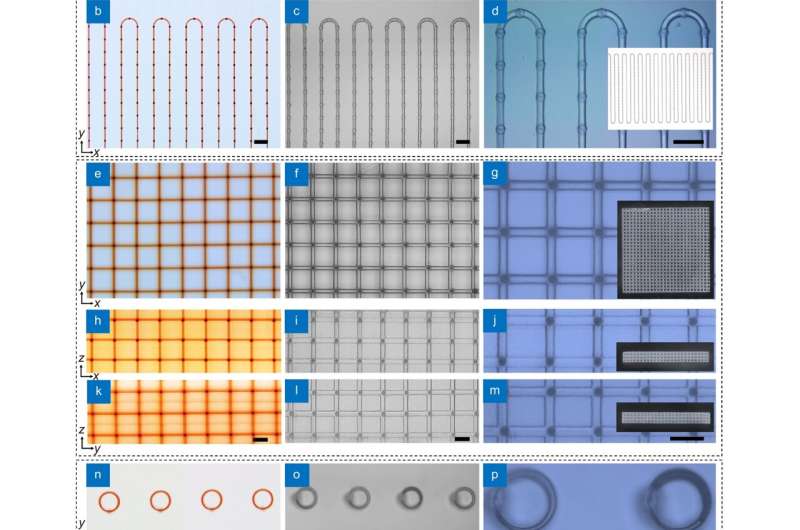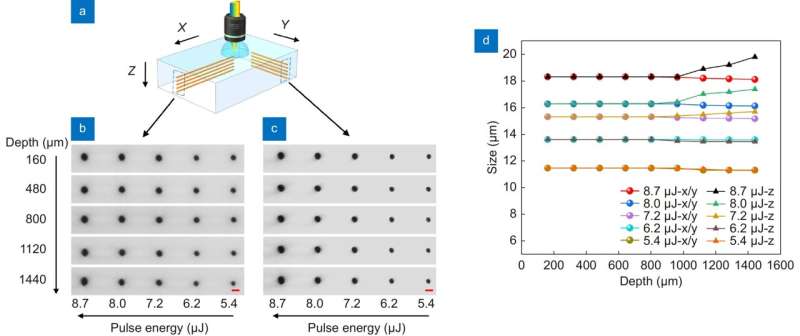This article has been reviewed according to Science X's editorial process and policies. Editors have highlighted the following attributes while ensuring the content's credibility:
fact-checked
proofread
3D isotropic microfabrication in glass using spatiotemporal focusing of femtosecond laser pulses

Femtosecond (fs) laser direct writing (FLDW) is a laser micro/nano manufacturing technology that can focus the laser pulses on the surface or inside the material, causing local changes in material properties through nonlinear laser-material interactions, which has been widely used in many fields such as micro/nano photonics, integrated optics, microfluidics. Conventional FLDW has the problem of asymmetric lateral and axial fabrication resolution, the axial resolution is significantly elongated, which limit the application of femtosecond lasers in 3D processing.
In recent years, several beam shaping techniques have been proposed to balance the difference between lateral and axial resolution in FLDW, such as slit shaping technology, astigmatism shaping technology, and cross-beam irradiation technology. However, these techniques cannot achieve three-dimensional isotropic processing based on a single objective lens.
Simultaneous spatiotemporal focusing (SSTF) technique was originally developed for bio-imaging applications and has been applied in fs laser micromachining. The SSTF technique provides a new temporal focusing dimension, making it prominent in improving the axial fabrication resolution and eliminating the nonlinear self-focusing effect.
The mechanism of the SSTF technique is that different frequency components of fs laser pulses are spatially dispersed by gratings and then recombined by an objective lens, pulse width at focal point of objective lens is restored to fs level.
Currently, most research on 3D micromachining of fs laser SSTF technique are based on Ti: sapphire chirped pulse amplification system with wide bandwidth and low repetition rate, which limits the speed of laser processing. Therefore, applying SSTF to high-repetition-rate fs laser sources is an inevitable requirement for achieving high efficiency and three-dimensional isotropic processing simultaneously.
However, the bandwidth of high-repetition-rate fs laser source is usually narrow, the spatial dispersion introduces a large number of negative time chirps, the laser itself cannot provide enough time compensation, resulting in the pulse width at the focus cannot restore to fs level, limiting the application of SSTF technique in high-repetition-rate laser processing. Therefore, 3D isotropic microfabrication in transparent materials using SSTF high-repetition-rate fs laser pulses need additional time compensation.
The authors of an article published in Opto-Electronic Advances propose a pulse compensation scheme by building a pulse stretcher outside a high-repetition-rate fs laser source for the generation of the SSTF fs laser pulses, which realize truly 3D isotropic microfabrication with a tunable resolution ranging from 8 µm to 22 µm in glass.
In this work, a Martinez-type pulse stretcher was adopted to introduce a large number of positive temporal chirps, the output pulse width was stretched to the picosecond level, and then different frequency components of laser pulses were spatially dispersed by grating pair and then recombined by an objective lens, pulse width at the focus of objective lens was restored to fs level. The experimental system is shown in Fig. 1.

As we all know, femtosecond laser processing effect is related to writing direction, pulse energy and processing depth. To verify the 3D isotropic fabrication resolution using the SSTF scheme, authors demonstrated optical micrographs of the lines in glass at different depths along different directions and with different pulse energy (see in Fig. 2).
The experimental results show that in the SSTF scheme, all the cross-sectional profiles in both XZ and YZ planes were symmetrical and round-shaped, 3D tunable isotropic fabrication resolution ranging from 8 μm to 22 μm in glass can be achieved by varying the pulse energy of the fs laser, and the fabrication resolution were insensitive to the depth of the focal position. The significance of this work is mainly to meet the high laser processing efficiency and continuously 3D adjustable isotropic fabrication resolution, which provides a new technical means for laser processing.

To demonstrate the unique capability of 3D isotropic fabrication in glass with the SSTF scheme, authors demonstrated 3D isotropic microfluidic structures inside the glass fabricated by SSTF fs laser direct writing and chemical etching (see in Fig. 3). Compared with conventional laser processing, SSTF high-repetition-rate fs laser pulse has the advantages of high efficiency, 3D adjustable isotropic fabrication resolution. The research results are expected to be applied to the fabrication of 3D microfluidic chip, photonic chip and laser 3D printing.
More information: Yuanxin Tan et al, Three-dimensional isotropic microfabrication in glass using spatiotemporal focusing of high-repetition-rate femtosecond laser pulses, Opto-Electronic Advances (2023). DOI: 10.29026/oea.2023.230066
Provided by Compuscript Ltd




















